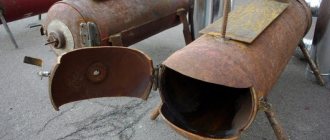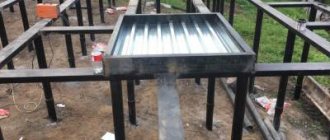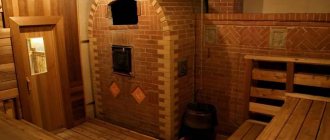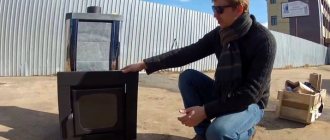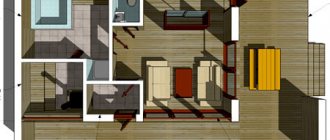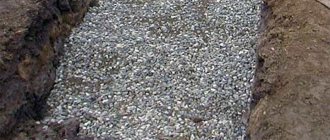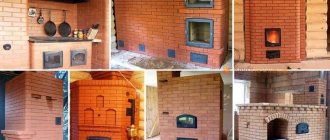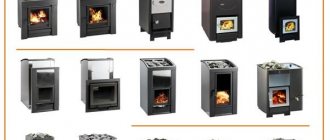Although the potbelly stove has a history of more than a century, it has not ceased to be a very popular heating device for small rooms.
Potbelly stove from a gas cylinder
Such a stove is made not only from solid sheets of metal, but also from various metal objects that can withstand the heat from an intense flame - it could be a barrel, a flask, a pipe or an old gas cylinder.
It is especially popular among avid motorists who, even in winter, cannot refuse improvements to their car, spending all their free time in garages. The gas cylinder has an ideal shape, it’s practically a potbelly stove, you just need to improve it slightly: cut off the excess, drill the necessary holes and add a few pipes! Let's take a closer look at how to make a potbelly stove from a cylinder?
A potbelly stove made from a gas cylinder can have a vertical or horizontal arrangement. Some craftsmen even make such stoves from two cylinders, placing one of them in a vertical position on top of the other, which is oriented horizontally.
Video: homemade wood-burning stove made from two cylinders
However, there are many models, and after considering different ones, you can choose the one that seems more convenient to use and acceptable in ease of execution.
Naturally, to make a potbelly stove from a cylinder you will need some tools and materials, as well as certain skills in working with them.
Methods of use and varieties
In our native land, a homemade stove made from a gas cylinder is a common source of heat in the winter. Most units are designed quite simply. According to the principle of operation, they are similar to a metal wood-burning stove: heat is released into the surrounding space through a body that is heated due to the combustion of wood (or other fuel). Homemade designs are used in the following situations:
- In the summer at the dacha for cooking food for people and animals.
- In winter for heating a garage, workshop, utility rooms.
- In residential areas for cooking and heating (enough for one or two small rooms).
- For heating the bath.
- A backup option in case of emergency failure of the main heating system.
Stoves converted from a gas cylinder do not have a single standard, but nevertheless, they can be classified according to the following parameters:
- According to the location of the cylinder. There are vertical and horizontal stoves; There are combined and double options. A vertical stove can often be found in a garage or utility room; horizontal ones are used for cooking and heating baths and living quarters.
Potbelly stove with hob Source termopaneli59.ru
- By design. A standard stove has a rather low efficiency; a significant part of the energy literally flies down the drain. There is an improved option: pyrolysis furnaces, which include the bubafonya furnace and the rocket furnace. They are designed to maintain long-lasting combustion.
- By choice of fuel. Mostly, potbelly stoves run on natural fuel - wood, but there are models that use coal, waste (diesel), peat, and pellets (pressed sawdust).
Pros and cons of the design
Every car enthusiast knows how uncomfortable it is in a garage without heating during the cold season. But excellent thermal conductivity and quick heat generation are not the only benefits of using a potbelly stove from a gas cylinder. Owners of garages, cottages and bathhouses are aware of other advantages of the heating device:
- Saving. Manufacturing requires standard, inexpensive parts. You get a unit at minimal cost, which is pleasantly different from the price tag of a finished metal stove. Available fuel is used for combustion.
Furnace in operation, operating mode Source ytimg.com
- Ease of manufacture. The work can be done on your own, without the involvement of specialists. There are a lot of videos collected online that can help you learn the technology for assembling a potbelly stove of any design.
- Convenient dimensions. You can make a device to fit the size of a bathhouse or garage.
- Easy operation and maintenance. The cylinder produces a stove suitable for heating baths, residential and utility rooms.
It is important to know about the following disadvantages of the device:
- To work, you need to choose reliable, proven drawings; The efficiency of a random unit may be low.
- Due to its design and material, the structure does not retain heat: as soon as the fire goes out, it immediately cools down.
- It is strictly forbidden to heat a potbelly stove with waste (used lubricants) in a residential area. This is not only harmful to health, but also a potential explosion and fire hazard. The place for installing any stove is finished with fire-resistant materials.
Diagram and dimensions of a country potbelly stove Source technicalservice59.rf
Stoves operating on exhaust have a separate drawback: due to the specifics of the fuel, more soot is formed, and the chimney has to be cleaned more often. In any case, when using liquid fuel, good air circulation is necessary, and this is possible with an established ventilation system.
Furnace modernization
Improving the operating parameters of the furnace is associated with an increase in its heat transfer. For this purpose, additional heat exchange surfaces are used on the furnace body. Such parts can be made from various metal profiles, including strips, angles, and profile pipes. The choice of material depends on what is available from leftovers.
Additional heat exchangers made of metal profiles increase the efficiency of the device
Additional heating surfaces can be installed not only on the outer surface, but also inside the firebox, which allows you to intensively heat the air in the room. A negative result of such a solution will be oxygen burnout at high temperatures.
Selection and preparation of the cylinder
The first thing you need to decide is the size of the metal container. The size is chosen based on the area of the room in which the cylinder stove is supposed to be installed. You can choose from the following options:
- 5 l cylinder. A five-liter container can heat a small room. Little fuel fits into it, and only in the form of chips or briquettes.
- For 12 l. The furnace will be able to provide small (up to 3 kW) thermal power. The heat is enough to warm a small workshop, utility room or gatehouse.
- For 27-30 l. You will receive up to 7 kW, which will be enough to heat a garage, garden house or greenhouse.
- For 40 l. Industrial cylinders have a small diameter and thick walls, therefore, the fuel load will be small. It is better to shorten such a container and make a small stove that will hold heat longer and last longer.
Potbelly stove with heater for a bath Source s-proms.ru
See also: Catalog of companies that specialize in the design and installation of fireplaces and stoves
- For 50 l. A propane cylinder is considered the best option for making a potbelly stove; Such dimensions are capable of providing heat to the cottage.
The cylinder needs preparation: removal of gas residues. If cleaning is neglected, an explosion may occur when cutting metal. The cylinder will become safe after the following measures:
- Unscrew the valve to get rid of any remaining gas. You need to set aside a day, so the container is left to vent the gas in the open air or in a non-residential area with good ventilation.
- Then the container is turned over to drain the condensate (any unnecessary container with a lid will do - condensation has a pungent odor).
- At the end, the container is filled with water to the very top for several hours to displace residual vapors. After draining the water, the cylinder can be cut without danger.
Features of operation of a pyrolysis furnace
The main difference between pyrolysis furnaces is the ability to use a wide variety of fuels. In solid fuel stoves, it is possible to burn not only traditional flammable substances, but also rubber, plastic and other materials that are strictly not recommended for burning conventional stoves.
This feature is associated with complete decomposition of the fuel and secondary combustion of the resulting gases in a separate chamber. After this, only carbon dioxide and water vapor remain in the smoke emissions. No harmful emissions into the atmosphere occur during pyrolysis.
But when using such fuel at the ignition stage, a persistent smell of burnt rubber remains in the room. Therefore, such heating units must be installed outside residential premises.
What materials and tools are needed
To make a garage or sauna stove from a gas cylinder, choose a steel, seamless propane (household) cylinder with the following dimensions:
- Case length: 1660-1755 mm. Diameter: 219 mm.
- Wall thickness: 5.2-8.9 mm.
The gas must be removed from the container Source f12.pmo.ee
Dimensions may vary, but maximum deviations (especially in thickness) must comply with GOST 949-73 standards. The tools you need to prepare are:
- Welding machine (200 A). Protective equipment (welding mask with light filter, gloves). Electrodes for welding structural steels (diameter 3-4 mm).
- Grinding machine (grinder). It requires cutting and cleaning discs for metal (diameter from 180 mm).
- Workbench with a vice.
- Drill and set of drills.
- To clean up welding slag: metal brush (with metal bristles), sandpaper.
- Tools: pliers, chisel, hammer.
- For marking: tape measure or folding meter, chalk (marker).
The range of materials depends on the size, shape and purpose of the structure. The middle list includes the following items:
- Pipe for chimney. Approximate dimensions: cross-section 120-150 mm, length 400 mm.
- Sheet of steel (thickness minimum 3 mm). The oven door is made of steel.
Stove with a horizontal heating device Source usamodelkina.ru
- Steel reinforcement or rod. Suitable for making a grate, you can make a handle for a door or a heater (if the stove is intended for a bathhouse).
- Metal corner or profile pipe. The materials will be useful for making legs.
If you plan to use a gas cylinder sauna stove, you will need a brick - this is used to build the foundation for the sauna structure. Diabase is ideal for filling the heater. Granite is not recommended; under the influence of high temperature it will quickly collapse.
If you do not have the opportunity to make a grate or other parts, you can purchase them ready-made. At this stage, you need to decide on the type of potbelly stove in shape. Taking into account the orientation of the housing (whether it will be located vertically or horizontally), all working operations are carried out.
Do-it-yourself potbelly stove from a gas cylinder: diagrams, drawings + step-by-step guide
So, when the fundamental decision to start working on a project has finally matured, it’s worth putting aside the irony and looking at things realistically. First of all, you need to remember about safety. A liquefied gas cylinder, although rusty, old, and with dents, but still sealed, is an item of increased danger. And this is all because, even though it was refueled a good ten to fifteen years ago, it still contains gas. When heated, the gas instantly expands and this leads to an explosion of the cylinder. And if you add a spark of flame to the gas vapor, then the explosion also results in a “light”, and such a force that metal 3 mm thick comes off and scatters over several tens of meters.
To prevent this, work with a metal container should begin with removing the valve. To do this, if it is possible and the valve itself is in working condition, you need to open it and drain the remaining gas liquid and odorant, a liquid added to the gas in order to hear its smell when it leaks. After the container is depressurized, the valve must be removed. This is done using adjustable wrenches. The valve is usually made of high quality bronze or bronze alloy, so it will take quite a bit of effort. The main thing is that when removing the valve there are no impacts and no desire to simply cut it off with a grinder.
After removing the valve, the cylinder is filled with water and soaked for at least 24 hours. Ideally, it is better to repeat this procedure 2-3 times, and also use some detergent to dissolve the remaining gas condensate. And only after this, when the metal has not yet dried from the water, you can start cutting the metal.
Constructing a drawing and drawing a drawing
If you look at the essence, these are two parallel processes. The first involves drawing the details of the future design, the second allows you to calculate how much material will be needed to translate the design into metal.
Drawing allows you to achieve a correct understanding of what will be installed and where, how to attach it and how to communicate with each other. Practical design directly on the model helps to greatly facilitate this process. A potbelly stove made from a cylinder is a kind of construction set, in which there is a main part - the body, and all the missing parts can be cut out of cardboard and temporarily attached to the body with tape. Such visualization allows you to see all the positive aspects and understand errors at the design stage.
Thus, the most difficult aspect of making a potbelly stove from an old gas cylinder is the installation of the firebox doors and ash pan. And there are no simple solutions here - when positioned horizontally, the convex shape of the top or bottom does not allow attaching straight doors. This means that there is a need to act outside the box, for example, to make the doors a remote structure.
Another point is the grate. If you make it from an ordinary 25 mm corner, then with a high degree of probability you can assume that such grates will not be enough for the entire heating season, which means you need to look for other solutions.
The design process also allows us to find non-standard solutions, for example, how to make the structure more stable. Should the vertical column have 3 or 4 legs? Or ask your neighbor for an old 17-gauge wheel rim and weld it to the base, thus ensuring both stability and strength.
Of course, some points can be neglected, but in everything related to safety, everything must be thought out and calculated many times. Therefore, everything that concerns the locks of the firebox and duct doors, the air supply regulator and the chimney, even the iron pan with sand in front of the potbelly stove, everything must be thought out to the smallest detail.
Cylinder markings
Having decided on the shape and type of gas cylinder stove, the body is marked. During marking, the installation points of the outer parts of the structures are drawn with a marker on the cylinder itself, the places where cutouts will be made and doors, grates, vents and chimneys will be installed are marked.
In order for the marking to be as accurate as possible, a center line is first drawn, and then marks are placed symmetrically from it and the remaining lines are drawn. Since the body structure itself is made of steel sheets, you can choose one of the side welds as the axial weld; in this case, there is no need to calculate where the axial weld will be located on the other side. It will also go along the weld.
Tools for work
In practical terms, working with metal is not difficult and does not require a specialized workshop. But what you definitely need is the following set of tools:
- Marker, square, tape measure and scriber;
- Metal drills, core;
- Mechanic's hammer and welder's hammer;
- A cutting disc for a grinder, an abrasive disc, a metal brush for cleaning (preferably two – one disc and one cup);
- A grinder, preferably a small one, with a disk of 125 or 150 mm - this size is more convenient to work with, and it’s easier to turn around than a huge 230;
- A welding machine; for beginners, an inverter with a hot start is better; for those who have already burned the first kilogram of electrodes, a regular transformer can be used;
- Gloves, goggles, a protective mask and a welder's mask are also required. Yes, just a protective mask and goggles, because you have to cut a gas cylinder, and here it’s better to be safe.
- You may need a drill.
- Vices and clamps are appropriate for the situation, but a few boards and 5 meters of thin wire will not hurt.
Preparing the body
The practical stage of the DIY gas cylinder potbelly stove project begins with dismembering the body. The procedure is simple and at the same time responsible. Before cutting begins, the container is filled with soap and water. After a few minutes of shaking and shaking, the water is drained and cutting with a grinder begins. It starts with the largest opening - the furnace doors. It is better to place them near the valve. The cut starts from the middle of the widest side of the doors from the center to the corners. After the cutout is made, the blower and chimney are cut.
After the rough processing is done, the edges are processed using an abrasive wheel and, if necessary, the edges are cleaned for welding using a brush.
Welding the legs
A stove made from a gas cylinder with a horizontal firebox must have legs that provide not only stability, but also the required height of the firebox above the floor level. It is better to make the legs using a template from boards. Corners or reinforcement, cut into the required lengths, are fixed on the template and welded together. The second leg can be welded by attaching the pieces to the already finished one, and again tied with wire. At the connection points, the seams are formed by welding; the final welding is done after removal from the template.
The legs are welded to the body at the attachment points that are marked on the body. This is done with several spot seams to check whether the stove will stand correctly on a flat surface. If the structure stands correctly, final fixation is done with long sutures.
Installation of doors and grate
The most complex design element is the firebox and plenum doors. To ensure that the doors fit tightly to the body, a 2-3 mm thick strip is used to tie the door opening on the side of the firebox. You can use 2-3 links of a motorcycle chain as hinges, or install regular door curtains mounted on bolts.
It is recommended to equip the vault door with an adjustable window; the damper can be made from a metal plate mounted on a bolt. For a volume of 50 liters, the diameter of the hole should be 25-30 mm; it can be burned through by welding, and then cleaned with an abrasive wheel.
The grate is welded from reinforcement with a diameter of 10-12 mm. The distance between the rods is taken to be 15-20 mm. For a potbelly stove made from a cylinder with a horizontal firebox, the grates are made along the entire length of the firebox; for a stove with a vertical layout, the grate must fit tightly to the body. For a stove with a vertical design, it is recommended to further strengthen the grate along its entire circumference by bending a circle of reinforcement with a diameter of 28-29 cm.
Manufacturing procedure
The orientation of the housing is chosen depending on the location and purpose of use. The horizontally positioned design is more convenient for cooking or bathing. The vertical version is often used for heating; They place it in garages: it takes up little space, and the traction in it is stronger.
Potbelly stove made from two cylinders in the garage Source ad-cd.net
Installation of a horizontal stove
The stove-stove is assembled in the following sequence:
- A square hole is marked and cut at the end to install the loading door (sometimes the end is cut off entirely).
- At the opposite end, according to the markings, a round hole is cut out for the chimney pipe.
- A hole for the grate is marked and cut out at the bottom. A box for collecting ash is welded under it (it is made of sheet metal).
- The ash chamber simultaneously plays the role of a blower, so it is supplemented with a door for adjusting the draft. To make the door, a fragment cut from the body is suitable, but you can supply a purchased part. The finished door makes the task easier, as it is equipped with a frame and a latch.
- To make a grate, thick reinforcing (knitting) wire is suitable; a lattice of the required size is cooked from it.
- For safe operation, reliable support is needed. Legs from a corner or runners from a profile are suitable as a stand. The supports are fixed to the body using spot welding; as a result, they must support the weight of the structure along with the loaded fuel.
Grate option Source ytimg.com
- A pipe - an adapter - is welded to the rear round hole, through which the chimney pipe is connected. The pipe needs a thick wall, otherwise it will quickly burn out under the influence of hot combustion products.
Consumables
In addition to the cylinder itself, for the construction of the furnace you need to purchase the following cast iron materials:
| No. | Name of material and stove fittings | Unit change | Quantity |
| 1 | Pipe with a diameter of 100 - 150 mm | m | 3 – 4 |
| 2 | Steel corner | m | 4 |
| 3 | Steel sheet | m² | 0,5 |
| 4 | Grate | PC. | 1 |
| 5 | Fire door 180x150 mm | PC. | 1 |
| 6 | Blower door 100x70 mm | PC. | 1 |
| 7 | Asbestos cord | m | 1,5 |
Video description
About making a stove from a cylinder for heating a garage in the following video:
Installation of a vertical potbelly stove
A vertical stove for a bath from a gas cylinder is made in the following order:
- The cylinder is fixed in a vertical position, the upper part is cut off with a grinder (where the fittings are), future holes for the firebox and ash pan are marked below (through which the potbelly stove will be cleaned of ash).
- Two holes are cut out on the front of the body using a grinder. The upper, large hole is for the firebox, the lower, smaller one is for the ash pan. You can use a gas or plasma cutter.
- A grate is installed between the furnace chamber and the ash pan. It is difficult to find it ready-made, of the required size and shape, so the lattice is made independently from reinforcing bars. The reinforcement is cut into pieces of the required size and welded inside the cylinder to the walls along a pre-marked mark.
Location of the firebox and blower Source vsaunu777.ru
Design features and principle of operation
Like any other direct combustion solid fuel stove, the unit, made from a gas cylinder, consists of several parts:
- firebox combined with the body;
- grate;
- blower chamber;
- chimney.
The blower is located at the bottom of the stove and is a small chamber (essentially a channel) necessary to supply oxygen to the combustion zone. To regulate the amount of air, monitor the process and remove ashes, the ash pan is equipped with a door.
Simple design is one of the components of the success of cylindrical potbelly stoves
In the middle part of the furnace there is a combustion chamber, which is separated from the ash pan by a grate. Being the main module of the heating device, the firebox simultaneously plays the role of a loading compartment and a heat exchanger. Like the vent, the firebox is equipped with a door through which firewood is placed into the potbelly stove and ash is removed.
The chimney is a channel necessary to remove combustion products from the working area. A damper must be installed in the chimney, which is closed after the wood burns out. This prevents heat from escaping from the room when the stove is not in use.
The operation of a heat generator from a gas cylinder is not difficult. After the firewood is placed on the grate, they are set on fire and the combustion chamber door is closed. The blower must be open at this time - air passes through it to the fuel. The intensity of combustion is controlled by closing or opening the bottom door. Heated gases are removed through the chimney.
To increase the efficiency of heat exchange, the potbelly stove is equipped with additional elements that allow the residual heat of the flue gases to be removed. To do this, an air heat exchanger or a water jacket is installed on the chimney. Often the modification consists of lengthening the part of the chimney that is located in the room.
Subtleties of operation
Like any potentially dangerous structure, a homemade sauna stove from a gas cylinder is made taking into account fire safety standards. To ensure its operation is correct, safe and economical, the following rules have been developed:
- A minimum gap of 20-30 cm should be maintained between the stove and concrete (brick) walls. There should be at least half a meter to other surfaces, while adjacent surfaces are finished with metal.
- For fire safety purposes, the stove is installed on a metal or concrete (brick) base.
- It is recommended to equip the chimney with a view (damper). This will help regulate draft and save firewood.
- Caring for a potbelly stove includes cleaning the chimney. It is carried out twice, before and after the heating season.
Two-story potbelly stove with increased heat transfer Source aviarydecor.com
Preparatory work
Before you start building a furnace, you need to carefully plan all stages of the work. In particular, you need to prepare a gas cylinder and select a place to install the heating device. As for the technology, using the step-by-step instructions presented below you can avoid mistakes and carry out installation in the shortest possible time.
How to empty a cylinder of gas residues
You cannot start cutting a propane or methane cylinder without preparation, since even a small amount of gas, condensate or its vapor in combination with atmospheric oxygen is an explosive mixture. The slightest spark is enough for an explosion to occur. You can make the container completely safe using the method presented below.
- Open the valve and release the gas from the container.
- Using an adjustable wrench or a gas wrench, remove the tap.
- Turn the can over and drain the remaining gasoline.
- Place the container vertically and fill it with water through the top opening. In this case, all flammable components will be displaced by the liquid.
- After drying the cylinder in the open air, you can begin any plumbing work, including welding and burning old paint with a blowtorch.
Like any other saturated hydrocarbons, propane and methane are odorless. To detect leaks, strong-smelling organosulfur compounds are added to it, so it is better to carry out all work on cleaning the cylinder in an open space.
Which location is suitable for installing the stove?
Even though we are looking at a mobile structure, most of the time it will be used to heat a garage, shed or workshop. To ensure that the operation of the heating device does not lead to unpleasant consequences, when choosing a location, they are guided by the current provisions of SNiP, sanitary and fire safety standards.
- The floor under the stove is constructed using non-combustible materials - fireclay bricks, cement-sand screed, asbestos fiber board or metal sheet.
- It is prohibited to install heating devices near storage areas for fuels, lubricants and other flammable materials and substances.
- When installing the stove, be sure to take into account the configuration of the chimney. The places where it passes through the roof must be protected with heat-insulating non-combustible materials.
- It is prohibited to install furnaces of this type under shelves, in places where attachments are close, etc.
- It is necessary to consider how the air flow into the room will be carried out. We should not forget that open-flame stoves consume a lot of oxygen.
- If the body of the heating device is located close to the flammable surfaces of the walls of the room, the latter are protected with heat-insulating shields.
When choosing a location for installing the stove, be sure to take into account the configuration of the chimney. Since most of the heat in direct combustion stoves is emitted into the chimney, they try to place it indoors, equipping it with a long horizontal or inclined section . It is just important not to overdo it with its length and number of turns, since the traction force, and therefore the thermal power of the heating device, depends on this.
Briefly about the main thing
A potbelly stove, converted from a gas cylinder, has remained a popular heating device for decades. It confidently copes with heating small rooms, has convenient dimensions, and can be done by a home craftsman with basic skills in welding and plumbing.
Large household gas cylinders are best suited for production. By design, horizontal and vertical models are distinguished; the former are convenient for cooking, the latter often serve as a source of heat in the garage, bathhouse or country house. The finished stove is installed in a prepared room and operated in compliance with fire safety rules.
Ratings 0
Video: How to make a super wood-burning stove from a used cylinder
The proposed options are only a small part of what was invented by folk craftsmen. Look how the craftsman combined brickwork and a gas cylinder in one potbelly stove:
If you have an understanding of working with the tools described above and all the necessary materials, you can try to make this convenient and sometimes irreplaceable stove yourself. By making it yourself, you can save quite a large amount, and also make an already unnecessary gas cylinder function. The most important thing is to approach this work responsibly and do it slowly, checking every action.
Important nuance
There are two types of gas used in everyday life. More precisely, two compositions of the gas mixture. And the characteristics of these mixtures differ greatly:
- Main gas , which consists of methane with an indicator - a strong-smelling component that allows you to quickly detect a leak. The main difference is that the mixture is lighter than air. Therefore, in a properly made furnace, a leak in the fittings is not a problem - the gas will simply go through the direct-flow system into the pipe, onto the street.
- A mixture of propane and butane is what is “packed” into cylinders at gas filling stations. This blend is better known as liquefied domestic gas. An important difference is that it weighs more than atmospheric air. As a result, in the event of a leak, it becomes very dangerous, since it can accumulate in the room or firebox of a stove converted to gas.
Hence the rule! You should not make your own stoves with gas burners designed for bottled gas.
And even the presence of a gas tank does not help - the same propane-butane mixture is filled into it.
Accordingly, if there is a gas main near the house, you can make a project, a permit and bring the pipe into the house. And instead of a boiler with a system of pipes, batteries or water circuit registers, install a furnace in which to burn gas.
But if only a bottled gas supply option is available, then there is no place for homemade products. We need to go a little different way.
What to do in the oven
First point. Burnt gas produces a higher temperature than wood. Consequently, the internal volume of the converted furnace must be lined with refractory bricks. It is necessary.
Second point. There should not be any closed volumes left inside the furnace where there is a risk of gas accumulation due to possible malfunctions of the gas shut-off, control and supply valves.
To do this, they completely change the operating principle of the furnace - they remove all channels or caps and make the furnace non-revolving, direct-flow. That is, the pipe is placed on the stove (stoves with a bottom pipe connection cannot be altered). And inside, in the path of hot gases, dividers are placed in a checkerboard pattern - small slotted partitions.
Or they resort to variable volume - much like a silencer for a firearm. That is, several horizontal partitions are placed along the path of hot gases. In them, successive moves are made opposite each other. Although, in this case, heat extraction occurs somewhat less successfully.
But it’s worth keeping a similar scheme in mind if for some reason it doesn’t work out with the dividers.
How to assemble a structure with a water jacket
The manufacture of the chimney is carried out in the following sequence of operations:
- Carefully cut the balloon at the top. The resulting cap is subsequently used to make a lid for the boiler.
- The bottom of the cylinder is equipped with homemade legs. Each of them must be exactly level before fixing.
The piston is constructed in three stages:
- A steel circle is cut out: in cross section it should be approximately 35-45 mm smaller than the internal diameter of the cylinder. Thanks to the side gaps, pyrolysis gases will leak into the secondary chamber without interference. A hole is made in the center of the circle for the air duct: this pipe should be inserted into it quite tightly.
- Next, the metal circle and pipe are welded to each other.
- A piece of channel is welded on top of the piston base.
To make a furnace lid, you can use the upper cut part of the cylinder. On its surface, markings are applied for the air duct pipe with a fixed supply piston. In this case, it is necessary to provide a certain margin for the free movement of the pipe. Cutting is done along the drawn lines. On the side, the homemade lid is decorated with handles, for which fittings bent in a vice are used. Now you can begin installing the chimney at the top of the improvised pyrolysis oven. Using a grinder, a cutout is made for the pipe blank: welding is also used to fasten the parts.
To increase the quality of chimney draft, it is recommended to make it from two elbows perpendicular to each other. To do this, a cut is made at the end of the pipe section leaving the furnace at an angle of 45 degrees, after which it is connected by welding to a piece of pipe of the same diameter. It would not be superfluous to take care of additional protection for the chimney from the ingress of debris and climatic precipitation - a reflective cap is usually made for these purposes.
At this point, the main part of the work on the construction of Bubafoni is considered completed: it can be put into operation. It is advisable to install the stove on a pre-arranged foundation.
How to use it correctly?
Before you start cooking, you must first remove the cauldron from the stove and heat the inside of the device using a small portion of firewood. In this way, you can eliminate any remaining odors and check the tightness of the installation of doors and chimneys.
During further operation, observe the following rules:
- when fuel burns, the surface of the container and its legs are completely heated, therefore, to ensure fire safety, the structure must be installed on a thick sheet of metal;
- regularly clean the oven from ash residues;
- use only solid fuel for heating. It is strictly prohibited to pour liquid petroleum products into this model of furnace;
- limit the access of children and animals to the heated device;
- do not place the stove near flammable objects;
- Do not light the stove with flammable liquids;
- such a stove is not suitable for burning household and construction waste;
- it is advisable to use only dry firewood, since when raw wood burns, drops of condensation will form and settle on the working elements of the device;
- equip the stove chimney with a spark arrester in the form of a tin can with a large number of holes made with an awl.
Cooking
